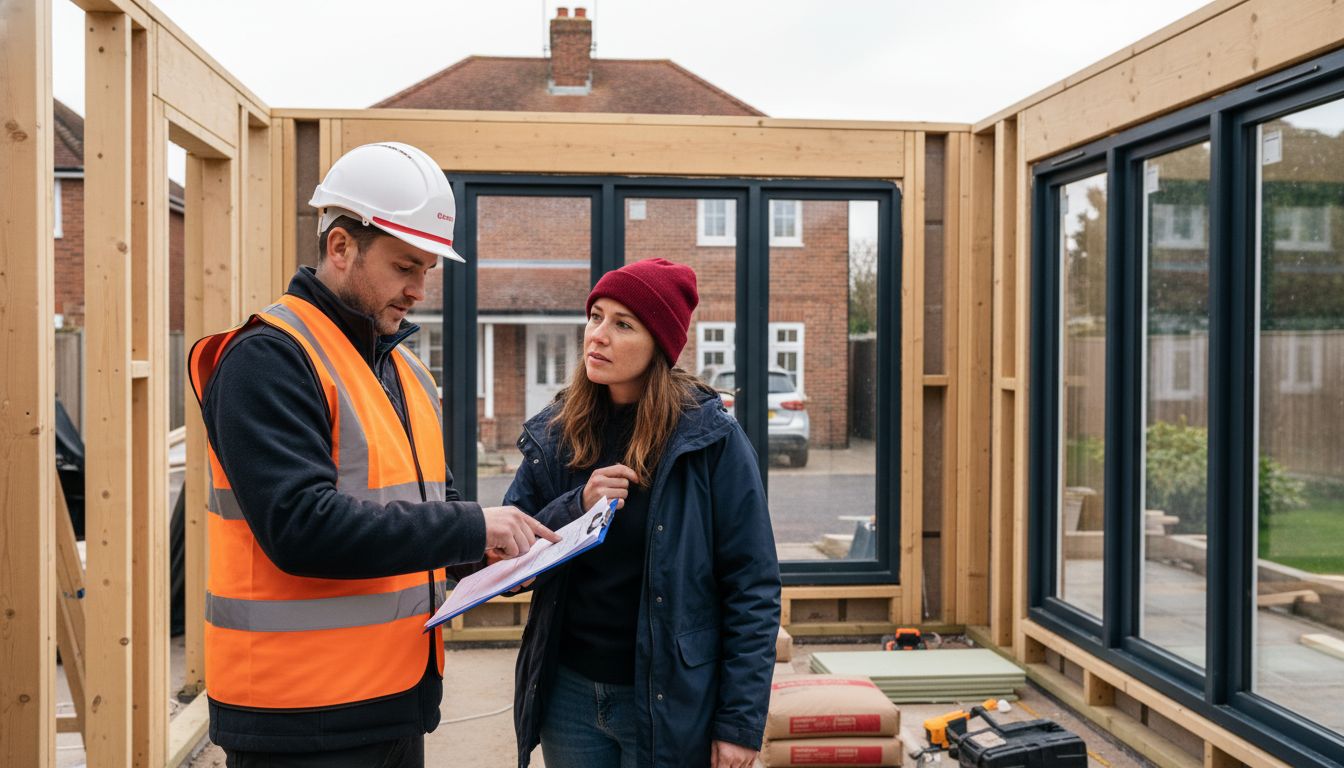Did you know that almost half of homeowners regret not planning their extensions thoroughly before starting work? A lack of clear goals and preparation often leads to wasted time and money. Understanding how to approach each stage sets the foundation for a satisfying upgrade, whether you want more space or to improve your home’s value. Careful planning can help you turn an ambitious idea into a smooth, stress-free project with lasting results.
Table of Contents
- Step 1: Assess Your Space And Define Extension Goals
- Step 2: Engage Professionals And Develop Initial Designs
- Step 3: Secure Planning Permission And Meet Regulations
- Step 4: Finalise Detailed Plans And Project Costs
- Step 5: Oversee Construction And Ensure Quality Standards
Quick Summary
| Key Point | Explanation |
|---|---|
| 1. Assess Your Space Thoroughly | Evaluate your current layout to identify areas for extension and set clear objectives for the project. |
| 2. Collaborate with Experienced Professionals | Engage qualified architects and designers to ensure your vision is translated into a feasible and functional design. |
| 3. Understand Planning Permissions | Research local regulations early to determine if your extension qualifies for permitted development or requires formal applications. |
| 4. Create Detailed Project Plans | Develop comprehensive plans and budgets, ensuring all potential costs and logistics are accounted for accurately. |
| 5. Monitor Construction Progress Regularly | Actively oversee the construction phase, holding meetings and reviewing work to maintain quality and stay on schedule. |
Step 1: Assess Your Space and Define Extension Goals
Starting a home extension project begins with understanding your current space and clarifying your specific goals. This initial assessment is crucial for creating a tailored plan that transforms your property exactly how you want.
Carefully examining your existing property layout helps identify potential expansion areas and opportunities. According to research from the Federation of Master Builders, determining the precise purpose of your extension is fundamental to making informed decisions throughout the project. Whether you want to add a new bedroom, expand your kitchen, create a dedicated home office, or increase overall living space, having crystal clear objectives will guide every subsequent design choice.
Start by walking through your home and critically evaluating each room. Consider which areas feel cramped or underutilised. Measure current room dimensions and note architectural features like window placements, load-bearing walls, and existing structural elements. Take photographs from multiple angles to help visualise potential changes.
Pro Tip: Sketch rough ideas or use online room planning tools to experiment with potential extension layouts before committing to professional designs.
Think strategically about how the new space will integrate with your current home. Will the extension improve natural light? Create better flow between rooms? Add value to your property? These considerations will help you develop a more purposeful design approach.
Once you have a clear vision, you will be ready to move forward to the next critical stage: consulting with professional architects and extension specialists who can transform your initial ideas into a comprehensive, achievable plan. Explore our step by step extension guide to understand what comes next in your home transformation journey.
Step 2: Engage Professionals and Develop Initial Designs
With a clear vision of your extension goals, the next crucial step is partnering with the right professionals who can transform your ideas into a tangible, feasible design. This stage involves selecting experienced architects, designers, and potentially structural engineers who will help bring your home improvement dream to life.
According to the Federation of Master Builders, collaborating with seasoned professionals ensures your extension is both functional and aesthetically pleasing. These experts will assist in developing initial designs that align perfectly with your goals, budget, and the unique characteristics of your property.
Start by researching and interviewing potential architects or architectural designers who specialise in residential extensions. Look for professionals with proven experience in projects similar to yours. Review their portfolios, check client testimonials, and request references. During initial consultations, communicate your vision clearly and ask about their approach to design, understanding of local building regulations, and experience with properties similar to yours.
Pro Tip: Request a comprehensive initial consultation that includes a preliminary design sketch and rough cost estimate to ensure alignment before making a significant commitment.
During the design development phase, expect multiple iterations and collaborative discussions. Your chosen professionals will create detailed drawings that consider critical factors like structural integrity, natural light, spatial flow, and compliance with local planning regulations. They will help you understand potential challenges and innovative solutions specific to your property.
Remember that good design is an interactive process. Be open to professional suggestions while staying true to your original vision. Explore our home extension planning checklist to understand the key considerations during this exciting stage of your home transformation journey.
Step 3: Secure Planning Permission and Meet Regulations
Navigating the legal landscape of home extensions can seem complex, but understanding planning permissions and building regulations is crucial to ensuring your project moves forward smoothly and legally. This stage involves carefully evaluating your extension plans against local and national building requirements.
According to the Planning Portal, most home extensions require approval under Building Regulations, even if they fall under permitted development rights. Research from Which? highlights that permitted development rights allow homeowners to make alterations without full planning permission, provided specific criteria are met.
Start by determining whether your proposed extension qualifies for permitted development. This depends on several factors including the size, height, location, and potential impact on neighbouring properties. Key considerations include the extension’s proximity to property boundaries, its total floor area, and how it might affect the existing building’s appearance.
Pro Tip: Always consult your local planning authority early in the process to confirm exactly what permissions you will need.
For most residential extensions, you will need to submit a formal application that demonstrates compliance with building regulations. This typically involves providing detailed architectural drawings, structural calculations, and evidence of how your extension meets safety, energy efficiency, and structural integrity standards.
Prepare comprehensive documentation that clearly shows your extension meets all necessary requirements. This might include site plans, elevation drawings, and technical specifications that prove your project will not negatively impact surrounding properties or infrastructure.
Learn more about planning permission requirements to ensure your extension journey starts on the right foot. Your next step will involve finalising these technical details and preparing for the formal approval process.
Step 4: Finalise Detailed Plans and Project Costs
With initial designs and permissions in place, it is time to transform your extension vision into a precise financial and technical blueprint. This critical stage involves creating comprehensive plans and developing a realistic budget that accounts for every aspect of your home improvement project.
Research from HomeBuilding suggests utilizing online extension cost calculators to estimate financial requirements. According to Living Etc., home extension costs in the UK vary significantly depending on project complexity. Single-storey extensions typically range between £1,800 and £3,500 per square metre, while double-storey projects cost between £1,650 and £3,250 per square metre.
Work closely with your architectural team to develop incredibly detailed plans that include exact measurements, material specifications, structural requirements, and precise costings. These comprehensive documents will serve as your project roadmap and help prevent unexpected expenses or delays.
Pro Tip: Always include a contingency budget of 10-15% to cover potential unexpected costs or minor design adjustments.
Break down your budget into clear categories such as design fees, construction materials, labour costs, architectural drawings, planning permissions, and potential site preparation expenses. Get multiple quotes from reputable contractors to ensure competitive pricing and realistic expectations.
Carefully review each line item and discuss potential cost-saving strategies with your design team. Consider alternative materials or phased implementation if the initial budget seems challenging. Explore our comprehensive home extension budget checklist to ensure you have not overlooked any critical financial considerations. Your next step involves selecting the right contractors who can bring these meticulously planned designs to life.
Step 5: Oversee Construction and Ensure Quality Standards
As construction begins, your role shifts from planning to active project management. This stage requires consistent attention, communication, and strategic oversight to ensure your extension materialises exactly as envisioned.
According to the Federation of Master Builders, regular monitoring during construction is essential to guarantee the work aligns with agreed plans and quality standards. Prompt issue resolution can prevent potential delays and unexpected additional costs.
Schedule weekly site meetings with your primary contractor to review progress, discuss any emerging challenges, and confirm that workmanship meets the highest professional standards. During these meetings, carefully compare ongoing work against your original detailed plans, checking that every aspect from structural integrity to finishing details matches your expectations.
Pro Tip: Take systematic photographs of each construction phase. These serve as valuable documentation and can help resolve any potential disputes or misunderstandings.

Maintain open communication channels with your construction team. Be available to answer questions quickly, but also trust the professionals you have carefully selected. Their expertise is crucial in navigating unexpected technical challenges that might arise during the build.
Carefully track progress against your agreed project timeline and budget. Any significant deviations should be discussed immediately with your project manager or lead contractor. Review our extension project timeline checklist to help you stay organized and proactive throughout the construction process. Your next step involves preparing for the final stages of completion and interior finishing.
Here’s a summary of key actions for each step in your home extension journey:
| Step | Main Actions | Key Considerations |
|---|---|---|
| Assess & Define Goals | Measure rooms Identify unused space Set clear objectives | Purpose of extension Current layout Potential impact |
| Engage Professionals | Research architects Request consultations Review portfolios | Experience level Design approach Understanding regulations |
| Planning Permission & Regulations | Check eligibility Consult local authority Prepare documentation | Permitted development Building compliance Neighbour impact |
| Finalise Plans & Costs | Develop detailed drawings Obtain contractor quotes Set a budget & contingency | Material choice Cost breakdown Contingency planning |
| Oversee Construction | Hold site meetings Document progress Track budget & timeline | Workmanship standards Communication Issue resolution |
Take Control of Your Home Extension Journey with Expert Support
Embarking on the extension design process can feel overwhelming with all the decisions, permissions, and planning involved. The challenge is making sure your vision comes alive without surprises or delays. If you found yourself needing clear guidance on every stage, from initial ideas to managing construction quality, you are not alone. Many homeowners share the goal of creating a beautiful, functional space that fits their lifestyle while navigating complex regulations and budgets.
That is where our experience at Reltic Extend makes a real difference. We specialise in helping London and Surrey homeowners turn their bespoke home extension dreams into reality. Whether it is architectural design, securing planning permission, or seamless project management, our team is here to support you every step of the way. Discover practical advice and proven strategies on Design & Build Tips for Home Extensions | Reltic Extend and understand the legal landscape with our resources on Planning & Permissions for Home Extensions | Reltic Extend. To take that confident next step towards a stress-free extension, reach out directly through our contact page and start transforming your home today.
Frequently Asked Questions
What are the first steps in the extension design process?
Start by assessing your current space and defining your specific extension goals. Walk through your home, evaluate each room, and identify areas that need improvement or expansion.
How do I choose the right professionals for my extension project?
Research and interview architects or designers who specialize in residential extensions. Look for those with experience in projects similar to yours, and request preliminary designs to ensure they align with your vision.
What do I need to know about planning permissions for my extension?
Most home extensions require approval under Building Regulations, even if they fall under permitted development rights. Consult your local planning authority early in the process to confirm the specific permissions needed for your project.
How can I estimate the costs involved in my home extension?
Utilize online extension cost calculators to get a preliminary idea of your budget. Break down your costs into clear categories and obtain multiple quotes from contractors to ensure you have a realistic and comprehensive financial plan.
What should I do during the construction phase of my extension?
During construction, maintain consistent communication with your contractor and conduct regular site meetings to monitor progress. Document each phase of construction with photographs to keep track of any changes or issues that arise.
How can I prepare for potential challenges during the extension process?
Identify potential challenges by thoroughly reviewing your detailed plans with your architects and contractors. Discuss strategies to address possible issues early on, which can help reduce delays and unexpected costs during construction.




